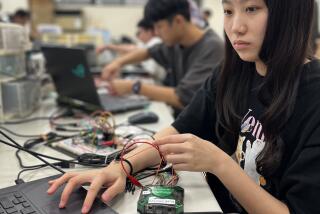Pittsburgh Forging a High-Tech Future : Steel Capital Refocuses Its Economy
- Share via
PITTSBURGH — The old mill had stood for generations along the river bank near this city’s downtown, spewing out steel for Jones & Laughlin and pollution for everyone else in Pittsburgh.
In its heyday, back when all the blast furnaces in western Pennsylvania were working overtime, it was also a symbol. As the only major mill inside the city limits, it was a visible monument to the hot metal that made the Pittsburgh area flourish.
Today, the American steel industry has collapsed and much of the old J&L; mill has shut down. Still, it has become a symbol once more--this time of the rapid transition in Pittsburgh from a dependence on heavy industry to a more diversified service and technology-based economy. Part of the mill is to be leveled by the city so the site can be developed into an industrial park for new high-technology companies.
The development at the J&L; site is just one aspect of a startling phenomenon in Pittsburgh--America’s steel capital is on the verge of becoming a strong regional center for computer-based high technology.
Great Changes Already
But what is most surprising is the extent to which the city’s economy has already changed; in the Pittsburgh metropolitan area, more people now work in high-tech fields than in basic steelmaking.
“There’s been a fundamental transformation going on here,” observes Timothy Parks, executive director of the Pittsburgh High-Technology Council. “Now, we are very close to developing the kind of critical mass you need to have a real high-tech community, with new firms spinning off (of) established companies.”
While dozens of mills and thousands of steel jobs have been lost in the Pittsburgh area over the last decade, new high-technology start-up firms, many founded by computer researchers from Carnegie-Mellon University, have slowly gained a foothold in one of the oldest and most tradition-bound business communities in America.
Research Grows
Meanwhile, medical and university research has continued to grow, and many of the major corporations based here--despite Chevron’s acquisition of Gulf, Pittsburgh is still home to more than a dozen Fortune 500 companies--have continued their research and development efforts in the area even while laying off production workers. Now, Pittsburgh has the fifth-largest concentration of engineers of any city in the country.
So at the same time that steel jobs have been disappearing, high-tech employment has been steadily rising in Pittsburgh, and the two trends crossed paths sometime in the last three years, observers here say.
At least 50,000 workers are now employed in technology-related jobs in the Pittsburgh area, while steel employment has declined from 71,000 in 1975 to just 31,000 today, according to the Penn Southwest Assn., a local economic development group.
“The trend toward high tech here is changing the population of the city,” notes Larry Geisel, president of the Pittsburgh-based Carnegie Group, which develops artificial intelligence software for use in computer-aided manufacturing.
“The old mill towns outside Pittsburgh are dying, but in the city itself, where most of the high-tech activity is going on, we are going from 25% white collar and 75% blue collar to exactly the reverse.”
Largely Unnoticed
The gradual growth of Pittsburgh’s high-tech community went largely unnoticed, even by local civic leaders, until late in 1984 when the Pentagon, after a nationwide site selection process, made Pittsburgh the home of its new national laboratory for computer software research. The center’s task will be to become a nationwide clearinghouse for information about developments in software research, and it is expected to have 250 technical staffers within five years.
The Defense Department decided to locate its Software Engineering Institute on the campus of Carnegie-Mellon because of the school’s computer science department, which has a longstanding reputation as one of the top two or three in the country. (At the same time, many of the new high-tech firms here, especially those founded by Carnegie-Mellon scientists, are involved in developing computer software.)
So now, John Manley, the new director of the Pentagon’s software institute, predicts that Pittsburgh has a chance to become a national center for software development.
“I think there is no question that this center should help make Pittsburgh preeminent in software technology,” says Manley. “We should be like a magnet. We’ll become an information center on software if we are doing our job right. So eventually, people in software development might find they would be better off locating near us.”
Automation Technology
With its strong background in manufacturing, Pittsburgh is also developing a niche in automation technology. Carnegie-Mellon’s Robotics Institute, for instance, has 200 scientists and engineers, and is now the world’s largest industry-financed center for research in robotics and manufacturing technology.
American Simplex, a rapidly growing robot maker based here, is supplying robots to the auto industry and other manufacturers, and Ford has purchased a $20-million stake in the firm. (Ford has also acquired a 10% stake in Carnegie Group.) Biomedical research and development at Pittsburgh-area university medical centers has also spun off new businesses here.
Bactex, founded by a university researcher, is working on a gonorrhea vaccine, while Medrad/Intec has developed new technology for heart monitoring devices.
Most of the credit for the growth in new technology ventures here has been given to scientists from Carnegie-Mellon and the University of Pittsburgh. Economic development experts here say that most of the start-up firms have been founded by local academics who want to cash in on the commercial applications of their research. (By contrast, few researchers from the major corporations based here have taken the plunge to start their own firms.)
“We’ve been able to change Carnegie-Mellon into a school with an entrepreneurial spirit and that has spilled into the rest of the city,” says the school’s president, Richard Cyert. The University of Pittsburgh has even taken over Gulf’s huge industrial research center outside Pittsburgh, which was donated to the school by Chevron when it acquired Gulf. The college is attempting to lease space to small high-tech firms.
Not a Panacea
Still, even Pittsburgh’s biggest boosters concede that high tech has not been a panacea for the city. It hasn’t absorbed the region’s throng of laid-off steelworkers, and has had a relatively minor impact on the area’s overall unemployment rate, which is still more than 8%.
After all, notes Park, few middle-aged steelworkers could be retrained for computer jobs when they were laid off. And the slump in the computer industry nationally makes it difficult to predict future growth in high tech here.
But high tech has still taken some of the sting out of Pittsburgh’s other economic problems. “We are still embryonic compared to other regions,” concedes Parks. “We are not Route 128 in Boston, we may not even be as big as Philadelphia’s high-tech community, but we’re growing, and we’ve got a sense of momentum.”
More to Read
Inside the business of entertainment
The Wide Shot brings you news, analysis and insights on everything from streaming wars to production — and what it all means for the future.
You may occasionally receive promotional content from the Los Angeles Times.










